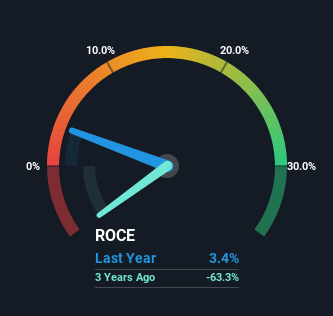- Spain
- /
- Healthcare Services
- /
- BME:MED
Investors Will Want Medcomtech's (BME:MED) Growth In ROCE To Persist
To find a multi-bagger stock, what are the underlying trends we should look for in a business? One common approach is to try and find a company with returns on capital employed (ROCE) that are increasing, in conjunction with a growing amount of capital employed. If you see this, it typically means it's a company with a great business model and plenty of profitable reinvestment opportunities. Speaking of which, we noticed some great changes in Medcomtech's (BME:MED) returns on capital, so let's have a look.
Return On Capital Employed (ROCE): What Is It?
Just to clarify if you're unsure, ROCE is a metric for evaluating how much pre-tax income (in percentage terms) a company earns on the capital invested in its business. To calculate this metric for Medcomtech, this is the formula:
Return on Capital Employed = Earnings Before Interest and Tax (EBIT) ÷ (Total Assets - Current Liabilities)
0.034 = €449k ÷ (€28m - €15m) (Based on the trailing twelve months to June 2021).
Thus, Medcomtech has an ROCE of 3.4%. In absolute terms, that's a low return and it also under-performs the Healthcare industry average of 8.9%.
Check out our latest analysis for Medcomtech

Historical performance is a great place to start when researching a stock so above you can see the gauge for Medcomtech's ROCE against it's prior returns. If you're interested in investigating Medcomtech's past further, check out this free graph of past earnings, revenue and cash flow.
What Does the ROCE Trend For Medcomtech Tell Us?
Medcomtech has broken into the black (profitability) and we're sure it's a sight for sore eyes. While the business was unprofitable in the past, it's now turned things around and is earning 3.4% on its capital. On top of that, what's interesting is that the amount of capital being employed has remained steady, so the business hasn't needed to put any additional money to work to generate these higher returns. That being said, while an increase in efficiency is no doubt appealing, it'd be helpful to know if the company does have any investment plans going forward. After all, a company can only become a long term multi-bagger if it continually reinvests in itself at high rates of return.
On a separate but related note, it's important to know that Medcomtech has a current liabilities to total assets ratio of 52%, which we'd consider pretty high. This effectively means that suppliers (or short-term creditors) are funding a large portion of the business, so just be aware that this can introduce some elements of risk. While it's not necessarily a bad thing, it can be beneficial if this ratio is lower.
The Key Takeaway
To sum it up, Medcomtech is collecting higher returns from the same amount of capital, and that's impressive. However the stock is down a substantial 77% in the last five years so there could be other areas of the business hurting its prospects. In any case, we believe the economic trends of this company are positive and looking into the stock further could prove rewarding.
If you'd like to know about the risks facing Medcomtech, we've discovered 2 warning signs that you should be aware of.
If you want to search for solid companies with great earnings, check out this free list of companies with good balance sheets and impressive returns on equity.
New: Manage All Your Stock Portfolios in One Place
We've created the ultimate portfolio companion for stock investors, and it's free.
• Connect an unlimited number of Portfolios and see your total in one currency
• Be alerted to new Warning Signs or Risks via email or mobile
• Track the Fair Value of your stocks
Have feedback on this article? Concerned about the content? Get in touch with us directly. Alternatively, email editorial-team (at) simplywallst.com.
This article by Simply Wall St is general in nature. We provide commentary based on historical data and analyst forecasts only using an unbiased methodology and our articles are not intended to be financial advice. It does not constitute a recommendation to buy or sell any stock, and does not take account of your objectives, or your financial situation. We aim to bring you long-term focused analysis driven by fundamental data. Note that our analysis may not factor in the latest price-sensitive company announcements or qualitative material. Simply Wall St has no position in any stocks mentioned.
About BME:MED
Medcomtech
Medcomtech, S.A. distributes products in the areas of orthopedic surgery, traumatology, neurosurgery, pain, and anesthesia worldwide.
Slightly overvalued with imperfect balance sheet.
Market Insights
Community Narratives




